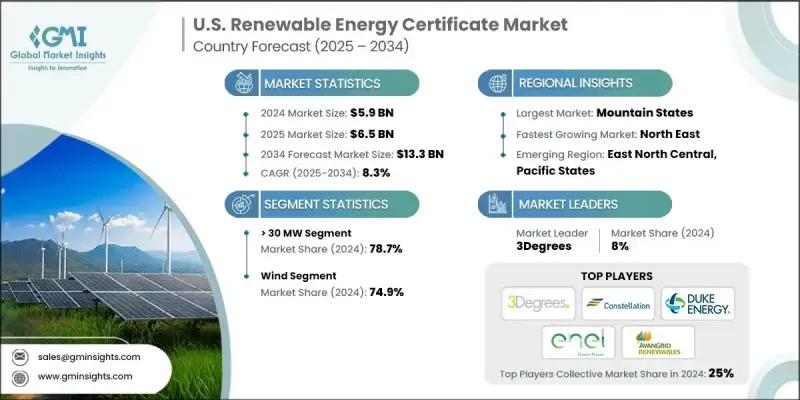PUBLISHER: Global Market Insights Inc. | PRODUCT CODE: 1833389

PUBLISHER: Global Market Insights Inc. | PRODUCT CODE: 1833389
U.S. Renewable Energy Certificate (REC) Market Opportunity, Growth Drivers, Industry Trend Analysis, and Forecast 2025 - 2034
U.S. Renewable Energy Certificate Market was valued at USD 5.9 billion in 2024 and is estimated to grow at a CAGR of 8.3% to reach USD 13.3 billion by 2034.

Major U.S. corporations are increasingly committing to 100% renewable energy and carbon-neutral operations. Purchasing RECs allows them to claim environmental benefits without directly sourcing green power, making RECs a critical tool in meeting ESG goals and voluntary sustainability commitments.
| Market Scope | |
|---|---|
| Start Year | 2024 |
| Forecast Year | 2025-2034 |
| Start Value | $5.9 Billion |
| Forecast Value | $13.3 Billion |
| CAGR | 8.3% |
Rising Adoption in >30 MW
The segment exceeding 30 MW held a significant share in 2024, owing to its alignment with utility-scale renewable energy projects. These large installations, often solar farms or wind parks, generate substantial volumes of RECs that feed both compliance and voluntary markets. Their scale offers cost efficiency and predictable output, making them attractive to utilities and corporations pursuing long-term renewable procurement contracts.
Wind Energy to Gain Traction
The wind energy segment generated a sizeable share in 2024, driven by its maturity, scalability, and strong policy support at both federal and state levels. Wind projects, particularly in the Midwest and Great Plains regions, are major generators of RECs due to consistent wind patterns and low operational costs. Buyers favor wind RECs for their relatively stable pricing and strong environmental credibility.
Mountain States to Emerge as a Propelling Region
The Mountain States renewable energy certificate market held a sustainable share in 2024. With vast open land, strong solar and wind potential, and growing state-level clean energy targets, the region is becoming a hub for new renewable energy projects. Colorado has implemented aggressive renewable portfolio standards, which are accelerating REC trading activity. Market players in this region are focusing on localized REC registries, regional grid integration, and cross-state transmission investments to align supply with demand. To strengthen their presence, companies are forming joint ventures, acquiring land rights, and investing in hybrid solar-wind-storage projects to ensure consistent REC output throughout the year.
Major players in the U.S. renewable energy certificate market are Ecohz, Shell, Native Energy, ENGIE, Carbon Better, Constellation, Avangrid Renewables, TerraPass, Climate Impact Partners, STX Group, ClimeCo LLC, EDF Trading Limited, Green Mountain Energy Company, Entergy, 3Degrees, Sterling Planet Inc., CMS Energy, Enel Green Power, Duke Energy Corporation, and Statkraft.
To strengthen their foothold in the U.S. Renewable Energy Certificate market, companies are leveraging a mix of strategic initiatives focused on scalability, credibility, and digitalization. Many are expanding their renewable energy portfolios to include multi-technology assets-such as solar, wind, and hydro-to diversify their REC streams and meet varying buyer preferences. Others are pursuing vertical integration by owning both generation and retail energy services, allowing them to offer bundled REC products directly to end-users.
Table of Contents
Chapter 1 Methodology & Scope
- 1.1 Research design
- 1.2 Base estimates & calculations
- 1.3 Forecast calculation
- 1.4 Data sources
- 1.4.1 Primary
- 1.4.2 Secondary
- 1.4.2.1 Paid
- 1.4.2.2 Public
- 1.5 Market definitions
Chapter 2 Executive Summary
- 2.1 Industry synopsis, 2021 - 2034
Chapter 3 Industry Insights
- 3.1 Industry ecosystem analysis
- 3.2 Regulatory landscape
- 3.3 Industry impact forces
- 3.3.1 Growth drivers
- 3.3.2 Industry pitfalls & challenges
- 3.4 Growth potential analysis
- 3.5 Porter's analysis
- 3.5.1 Bargaining power of suppliers
- 3.5.2 Bargaining power of buyers
- 3.5.3 Threat of new entrants
- 3.5.4 Threat of substitutes
- 3.6 PESTEL analysis
- 3.6.1 Political factors
- 3.6.2 Economic factors
- 3.6.3 Social factors
- 3.6.4 Technology factors
- 3.6.5 environmental factors
- 3.6.6 Legal factors
- 3.7 Emerging opportunities & trends
- 3.7.1 Digitalization and IoT integration
- 3.7.2 Emerging market penetration
Chapter 4 Competitive landscape, 2025
- 4.1 Introduction
- 4.2 Company market share analysis, 2024, by region
- 4.2.1 East North Central
- 4.2.2 West South Central
- 4.2.3 South Atlantic
- 4.2.4 North East
- 4.2.5 East South Central
- 4.2.6 West North Central
- 4.2.7 Pacific States
- 4.2.8 Mountain States
- 4.3 Strategic initiative
- 4.4 Competitive benchmarking
- 4.5 Strategic dashboard
- 4.6 Innovation & technology landscape
Chapter 5 Market Size and Forecast, By Capacity, 2021 - 2034 (USD Billion)
- 5.1 Key trends
- 5.2 < 5 MW
- 5.3 > 5 MW - 15 MW
- 5.4 > 15 MW - 30 MW
- 5.5 > 30 MW
Chapter 6 Market Size and Forecast, By Type, 2021 - 2034 (USD Billion)
- 6.1 Key trends
- 6.2 Voluntary
- 6.3 Compliance
Chapter 7 Market Size and Forecast, By Customer, 2021 - 2034 (USD Billion)
- 7.1 Key trends
- 7.2 Commercial
- 7.3 Residential
- 7.4 Wholesale
Chapter 8 Market Size and Forecast, By Source, 2021 - 2034 (USD Billion)
- 8.1 Key trends
- 8.2 Bioenergy
- 8.3 Hydro
- 8.4 Solar
- 8.5 Wind
- 8.6 Others
Chapter 9 Market Size and Forecast, By Region, 2021 - 2034 (USD Billion)
- 9.1 Key trends
- 9.2 East North Central
- 9.3 West South Central
- 9.4 South Atlantic
- 9.5 North East
- 9.6 East South Central
- 9.7 West North Central
- 9.8 Pacific States
- 9.9 Mountain States
Chapter 10 Company Profiles
- 10.1 3Degrees
- 10.2 Avangrid Renewables
- 10.3 Carbon Better
- 10.4 CMS Energy
- 10.5 Constellation
- 10.6 Climate Impact Partners
- 10.7 ClimeCo LLC
- 10.8 Duke Energy Corporation
- 10.9 EDF Trading Limited
- 10.10 Entergy
- 10.11 ENGIE
- 10.12 Ecohz
- 10.13 Enel Green Power
- 10.14 Green Mountain Energy Company
- 10.15 Native Energy
- 10.16 STX Group
- 10.17 Shell
- 10.18 Statkraft
- 10.19 Sterling Planet Inc.
- 10.20 TerraPass




